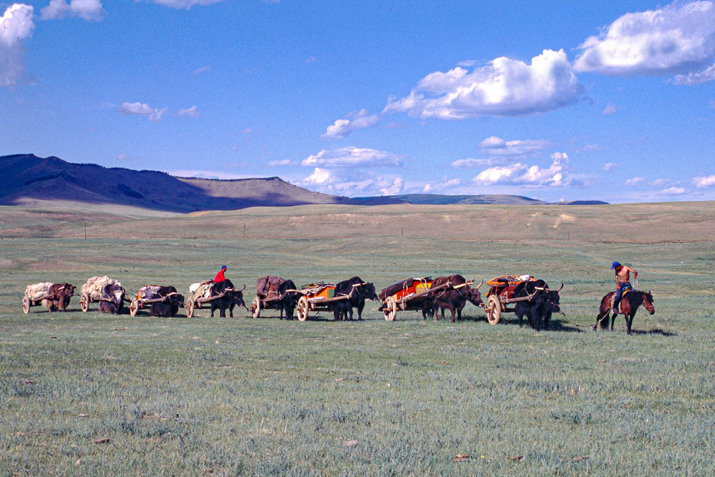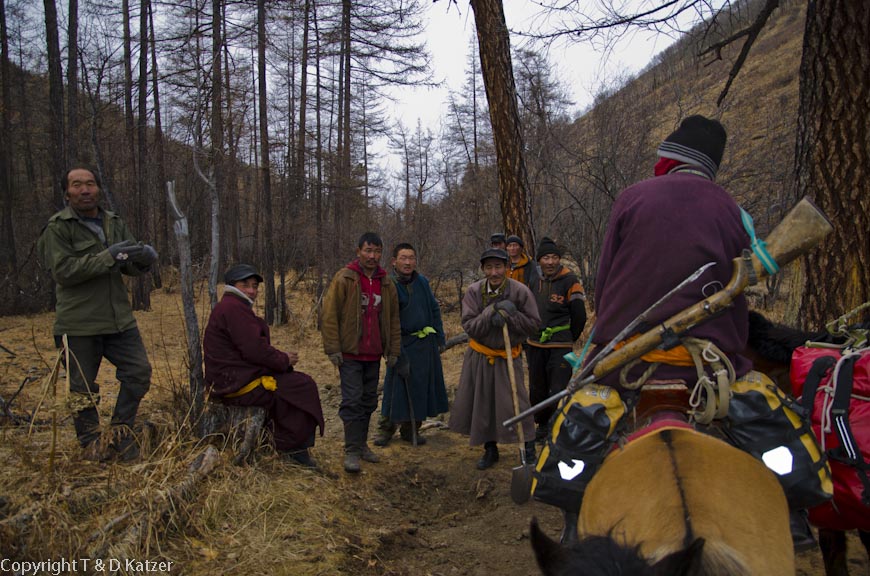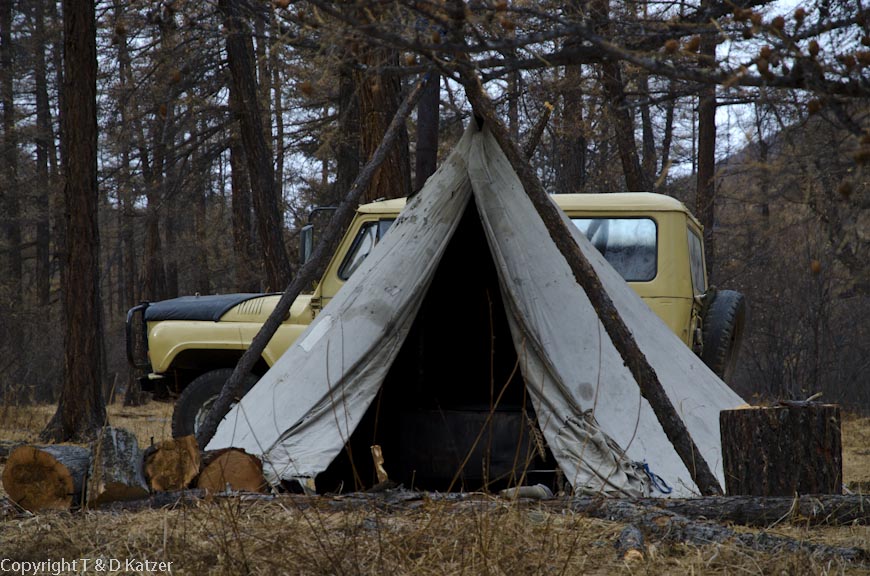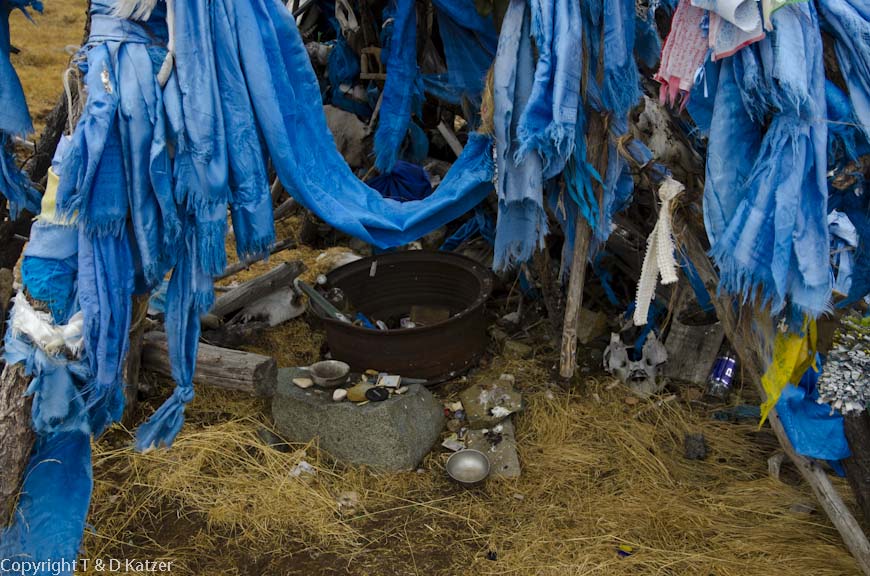
Risky river crossings and breaking ice floes
N 51°05'082'' E 100°00'042''
Day: 97
Sunrise:
08:06
Sunset:
18:01
As the crow flies:
21,52
Daily kilometers:
31,00
Total kilometers:
1026
Soil condition:
Ice floes, snow, rocks, boulders
Temperature – Day (maximum):
minus 3°C
Temperature – day (minimum):
minus 12°C
Temperature – Night:
minus 16°C
Latitude:
51°05’082”
Longitude:
100°00’042”
Maximum height:
2000 m above sea level
Time of departure:
12:00
Arrival time:
18:20













This morning our inner tent is once again a small ice castle. The frosty wind blows unabated from the gorge and rattles the tent canvas. The thermometer is at minus 12 °C at 9:00 am. and the water in the bags has frozen to a concrete-hard block. Not necessarily a morning when you want to get out of the tent to prepare breakfast. Tanja complains about cold fingers and feet as she tries to light a fire. Bilgee rides Sharga like an Indian without a saddle and drives the other hoofed animals to the lake. “The water is so cold that they barely drank it,” he says later.
At 12:00 noon we turn our backs on Lake Khuvsgul. We won’t be back until next year in early summer to ride all the way around the beautiful lake. By the time we reach the gorge, the wind has almost completely died down. We discover the first wolf tracks, which are much larger than those of dogs. “Must be big animals,” says Tanja. We follow a small frozen river. In some places, however, we can see the water gushing through a hole in the ice. “So there’s enough water for our horses here after all,” I realize with relief. The path we follow is bad. Roots, rough stones and millions of holes are lined up one behind the other and next to each other. As we had planned to cover at least 30 kilometers today, this wish gets stuck in the many hard-frozen holes in the path right at the start of the day. Unexpectedly, the frozen watercourse winds its way across our path. We carefully cross the slabs of ice. Taking great care to ensure that none of our animals slip and fall. The path climbs steadily with every meter. The steep mountain flanks to our left and right swallow up the sunlight and daylight. So it is quite gloomy. Suddenly we see the tracks of vehicles. “What kind of car must it be that can drive through and over this frozen field?” I wonder. “Do you hear that?” I say, listening into the forest. “What?” asks Tanja. “I think I can make out a chainsaw. There are trees being felled,” I’m sure. A few minutes further up the mountain, the sounds leave no room for doubt. Work is being done here. Then we come across people. For whatever reason, they are working on repairing the path at this time of year. It’s a kind of construction crew. The sometimes hideous figures look at us just as surprised and curious as we look at them. They are drawn faces. Red-cheeked from the cold, some wrinkled, they look at us. The smile of some of them softens their coarse appearance. Eight men between the ages of 20 and 55 are attempting what I believe will soon be the impossible. They widen the path so that cars can also get through. Not a car in the conventional sense, of course. If any vehicle can plow its way through the wilderness here, it has to be a massive Russian four-wheel drive jeep. Bilgee talks to the men, who have of course all stopped working. He asks for directions and, as usual, the men want to know where we are coming from and where we are going. “Oh to Tsagaan Nuur? And in winter? You must be crazy,” we hear, feeling ourselves shrink a little on our saddles. “It’s very cold there,” says one of them, shaking his entire body like a leaf. Well, we already know the picture. For me, however, it is astonishing to be warned of an apparently even colder place, even here in this cold, inaccessible wilderness. One of the men points at Mogi, raises an imaginary gun and shoots him. Then he grins cheekily while the others laugh. Can you tell Mogi is already a sheep killer? We say goodbye to the rough fellows a little later and continue our arduous ride. “Sain jawaaraj!” (“Have a good trip!”) they call after us. Just three hundred meters further on we come across their simple camp. Two Russian jeeps are parked next to two tepees in which they live. The men sleep on the floor. There is a cannon stove in the middle that provides sufficient heat. I take a few pictures and then follow Tanja and Bilgee.
From now on, we have to get out of the saddle more and more often, as the path constantly leads over the winding frozen watercourse. Riding is risky in many cases due to the slippery surface. We carefully pull our horses over the ice. Sometimes, however, the ice cover is brittle. To avoid getting wet, we are now forced to ride. Bilgee is increasingly looking for a ford through the river. Crossing it on unpredictable, opaque ice is risky. The water could be too deep if the horses break in. They could fall and go down with us. As so often on this journey, finding a ford across the ever-widening river is an unexpected challenge. Sometimes we follow the water until we discover an unfrozen or only slightly frozen area that tells us how deep it is at this point. “Here’s an opportunity!” Bilgee calls out and waves us over. Tenger shies away and doesn’t want to go into the knee-high water, which is fringed with ice. It takes Bilgee great effort to drive his stubborn Tenger through the cold waters. Ice breaks and scrapes. Falling in here would be fatal in the outside temperatures. Tanja follows Bilgee and pulls Sharga and Bor after her. It is an impressive sight. As I have to drive Bor so that he doesn’t stop in the middle of the ice flow and tear the lead rope out of Tanja’s hand, I am close on her heels. “Choo! Choo! Choo-choo!” I shout, spurring the horses on ahead of me. I hold Mogi’s lead and my reins in my left hand, while my right hand swings a rope, which occasionally comes down on Bor’s backside. “Choo! Choo! Choo-choo!” I shout at the top of my lungs.
The water splashes. Mogi has disappeared up to his waist. Ice cracks, floes crack and shatter under the weight of the animals. Breath steams out of the horses’ nostrils. When we arrive safely on the other bank, we are always relieved. Riding under such conditions is a challenge in a class of its own. Sometimes we have to cross a sea of football-sized pebbles. The horse’s feet carefully stilt through. I would love to capture this photographically but there is no opportunity to do so. We push on despite the snail’s pace. No pause for a photo. Bilgee is in a hurry. Constantly chased by the coming cold that every nomad has been announcing for days. Again we have to cross the river, which is strangely wider than it was ten minutes ago. Once again we cross the breaking ice floes in the same manner as we have done at least ten times today.
The widening mountain valley is lined with larch trees, which seem to be the only tree species present here. Due to the icy conditions and the resulting risk of slipping, we leave the path and ride up the mountain flank to our right, which we then follow along its length. I wonder whether that was a good or a bad decision. As it looks at the moment, the slope is a single mega spring that lets water flow into the valley along its entire length in summer. Now, on the other hand, we are walking on a huge ice surface that slopes downhill. The horses are slipping more and more frequently. Bor even falls to his knees three times, but manages to pull himself up just in time. My adrenaline level is at the max. Merging with Sar into a single being, I sense his every insecurity. It slips frequently. Fortunately, it has four feet. A two-legged friend would have been knocked on the head several times.
The thin larch forest around us is completely scorched here. A huge fire must have raged in this region in the summer, killing hundreds of thousands of square kilometers of forest. As far as we can see, as far as the peaks of the mountains to the left and right of the valley, the same charred corpses of trees rise their black trunks accusingly into the sky above. I turn in the saddle and catch sight of a blue glimmer of the Khuvsgul behind us. Then the lake, which is now much deeper, disappears behind the corpses of trees. “Chhhrrrrrt, chhhrrrrrt,” the solar panel loaded on Bor’s back scrapes past a charred trunk. “Watch out!” I warn Tanja, who is struggling to maneuver the horses through the maze of trees and ice.
Mogi pulls like a madman on his leash here too. I still have my difficulties with him and have longed for my two packhorses more than once in the last few days. However, I don’t want to give the impression that leading two packhorses is easy. Getting them through this terrain, especially on the icy ground, requires excellent riding skills. I keep looking at Tanja and am proud of her. What woman would share such a hard life of adventure with me? Maybe one in a million? Even though we have often heard that women would like to accompany us. The reality is usually completely unromantic. Looks great in the photos, but has little in common with so-called romance. Riding for days and weeks in this icy cold through a wild country that offers a new, unprecedented challenge around every bend is hard to digest. Once you have worked your way into this seclusion, there is no going back, only forward. But again, I don’t want to appear unfair in this explanation. Surely there are one or two women in whose breast beats a real heart of adventure. Not just for a few weeks, but a heart of Tanja’s quality, who has dedicated her entire life to adventure, exploration and extreme travel.
At an altitude of 2000 meters, we reach the top of the pass where an obligatory ovol stretches its thin trunks into the cloudy sky. Animal skulls hang from the wooden poles. Crutches and other stuff lie in the cave that has formed under the wood. As custom demands, we ride around the Ovol three times and wish each other health, luck and a safe expedition. From our elevated position at the end of the valley, we can once again see the Khuvsgul peeking up at us. Because we are now riding from the top of the pass into the somewhat lower regions of the high valley, we won’t see him again for many months.
We reach a huge river bed. At this time of year, there is also little water flowing in it. Nevertheless, we have to cross the watercourse, which is up to 20 meters wide. It is also frozen over in many places. The ice cover is also deceptive and breaks when horses step on it. Once again, we venture over the ice again and again. We ride over rock and scree. A shepherd drives his herd of horses towards us. He is on his way to Mörön. Bilgee and he have a brief exchange. Then we follow the tracks of the herd, which reveal the best spots across the river. Mogi leaps through the water like a chamois and in some places he sinks up to his shoulders in the icy waters. The lower part of the duffel bags is also submerged in the icy water. As soon as we reach the opposite bank, they are frozen hard. Thank goodness they are waterproof, so our equipment and spare clothes stay dry.
Suddenly it starts to snow. Exhausted from the dangerous pass crossing, we take a short break next to the large riverbed to fortify ourselves with hot tea and cookies. “Can’t smell the cookies any more,” I say, as we’ve been eating them for months during our break. “A delicious dark farmer’s bread with cheese and sausage would be a dream,” I lament quietly.
Before we move on, we slip into our warm Deels. Although the ground is frozen and slippery, we now take every opportunity to do kilometers at a trot. The horses’ coats are heavily frosted. Their white frozen nostrils in particular look downright fake.
Only 20 minutes after sunset do we agree to set up camp in a forest clearing. As there is plenty of grass to eat and a river runs through the valley not far away, it is ideal for our camp for the night.
As soon as our tents are pitched, we are visited in this secluded spot. It is a young woman and a man who come riding up on their horses. They are friendly and speak a different language. However, almost all of them also speak Mongolian. “They are not Mongolians but people from the small Darkhad tribe who live in this part of Mongolia,” explains Bilgee. As usual, the shepherds want to know what everyone wants to know and, as usual, Bilgee asks about the nature of the route ahead. Our visitors thank us for the cookies and hot tea. A gesture of hospitality that is one of the unwritten rules of conduct in Mongolia. Then the two disappear into the darkness. They follow their cattle, which they drive from some pasture to their home. For a while longer we hear the crunching of horses’ hooves and their calls. Then the darkness and the falling snow swallow up every sound around us.
Bilgee cooks his beef stew at minus 10 °C. As usual, he smashes the frozen dried meat with the blunt side of the axe. This way it becomes edible when cooked for about an hour. Later, we sit around our warming fire in heavy snowfall and devour the stew. “Doesn’t look good,” says Bilgee, pointing at the snow. “What do you mean?” I ask. “If it keeps snowing like this, the path will disappear and river crossings will become even more treacherous,” he explains. “Hm, we’ll make it. We have to be very careful and we’ll find the direction with the GPS,” I say confidently.
“How far is it to Tsagaan Nuur?” asks Tanja. “According to the map, it’s only 55 kilometers as the crow flies. If everything goes smoothly, we could be there in three days,” I ponder. So we’ve covered more kilometers today than we thought?” Tanja is surprised. “Indeed we have. According to my calculations, we probably covered 31 kilometers through the rough terrain. After crossing the pass, we were able to trot a lot. The country did well,” I explain in a good mood. “Hm, I’m glad when we’re sitting in the nest. Although I have to admit that I’m really enjoying this trip. To be honest, it’s one of the best trips of my life so far,” Tanja says quietly, gazing into the flames.
We look forward to your comments!

